1.
When I was a kid, I thought that ‘Yogyakarta’ was a stupid name. I mean, here’s an island (with the same name as the street I grew up on, hence the youthful interest) with a capital called Jakarta (birthplace of the American president!) and – on the same island – they name one of the cities almost exactly the same thing. Did they run out of names? It would be like if Toronto was called ‘Nottawa’.
But then I realized that the lack of original names applies more to Canadians and Americans (after all, how many of our cities are named after somewhere in Europe? Half of New York state seems to be named after Egyptian towns) than Indonesians. And now I’m in Yogyakarta (or ‘Jogjakarta’ – a name that would have endured even more contempt from a young Lindsay – or even ‘jogja’) and I’m falling in love with the city.
2.
It’s not immediately obvious why someone might fall in love with Jogja. It’s a city of 500,000 people with no landmarks. The first time you walk down the street there’s a 50% chance you’re going the wrong way as there’s nothing to orient yourself to.
Some of the sights in the town are downright forgettable. The water palace is a temple to the power of deferred maintenance and concrete brutalism to reduce even the most advanced cultures to nothing. You can walk the grounds and gaze upon brackish water and dirt masquerading as gardens.


Similarly, the sultan’s palace illustrates that mass production means we’re all sultans now. His collection of pottery is roughly akin to the gifts traded by middle class families at weddings (however, he did have a much nicer collection of palanquins than the average homeowner). Many a disappointed child roams the grounds of the cruelly labelled ‘palace’

It’s precisely this lack of truly majestic downtown sites that make the city so worth visiting. There are no grand buildings fighting for your attention so you’re forced instead to appreciate all the little things that make Jogja so great.
3.
As good a place as any to start is with a walk along the river. We wandered along the river between Juminhan and Senopati roads and had a great time.
You immediately notice a Javanese love for two things: flags and potted plants. The narrow, high traffic paths along the river’s edge are overgrown with flag-bearing standards and potted plants, creating an explosion of colour.



As you walk along the river, you’re greeted by some of the friendliest people I’ve ever met. Not a lot of foreigners come down here and everyone wants to say hi. Parents bring their children to say hi and kids follow you from the other side of the river.
As an aside, I’ve never seen a country where the media coverage of the population is so different from the population itself. If you just watch the news you might conclude that Indonesia is full of firebrand fundamentalist clerics launching hotel-and-then-hellbound suicide bombers. Nothing could be further from the truth.
This is a nation of people trying to pull themselves out of poverty and straight into a globalized 21st century. At times, walking along the river you’ll see how far there still is to go for one part of the population: there are public toilets and at one end there’s even a well.

4.
Another area that absolutely must be visited is Kotagede. The area is famous for two things, the first being silver.
If you go to H&S Silver, you can take a tour of their factory before buying 92.5% pure silver at what Wen assured me are prices about 1/3 of home. Make no mistake-despite all the work being done by hand, this place is a factory. The craftsmen have four months to learn their trade and then they pump out dozens of identical pieces a day.
However, it’s still charming to watch everything be made. I particularly liked the step where a local fruit is crushes to become the soap used to polish the silver.





Note that H&S Silver does primarily traditional designs. For something more contemporary, check out Borobudur Silver. It’s not technically in Kotagede, but also has a small workshop attached.
The other interesting aspect of Kotagede is it’s architecture. It’s one of the best places to see examples of traditional Javanese architecture.
At first this feels like an exercise in looking at roofs.
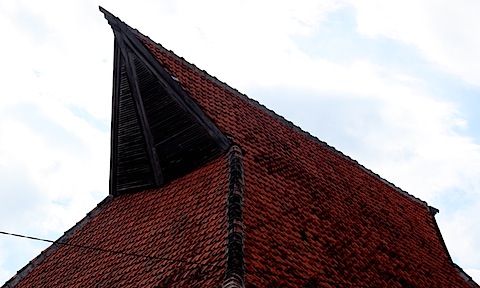

However, as you get deep into Kitagede you can wander down it’s flag-covered alleys (totally safe; the high traffic levels would bring a smile to Jane Jacobs’ eye) you start to catch glimpses of the wooden shutters and whitewashed walls.





Occasionally you’ll come to an open door and catch a glimpse of life inside. From what I can tell, every house has a central courtyard and, more often than not, an overhanging roof (it rains a lot and violently here) that will be dangling at least one bird cage.


A word on the birds: the Javanese love them. They’re everywhere. You see scooters in the street with the driver bearing a covered bird cage off the side. Many businesses have them outside their windows. The trishaw drivers will flap their arms in bird mimicry to entice you into a short, overpriced ride to the bird market.
But back to Kotagede. If you go far enough you’ll eventually find the factory-cum-showroom of Monggo Chocolates, an artisanal choclatier. Try the Ginger chocolate; if you can’t find the place, you might find their chocolate at the local Circle K.
To get to Monggo you’ll also pass the royal graveyard and ruins of the old Javanese palaces. Along the way you can see the local market and dangling trees that have been paved into place.
On the way back you can gawk at the Javanese house of R Pesik. Apparently he runs DHL Indonesia and chairs some ASEAN development group; when not doing that he lives like a modern day Javan king.


5.
The other thing to see in Yogyakarta are it’s temples. About 40km away is Prambanan, the largest Hindu temple in the world. It’s been rocked over the years by earthquakes (most recently in 2006) meaning that a lot of it is being restored. Since the government appears to be using the same folks who built are building the Sagrada Familia, there are a couple of generations to go until the restoration is complete.


Prambanan is the main temple complex, but the property also includes the Menwu temple. This too was damaged in 2006 and is now held together by the same construction materials it was built with over 1,000 years ago.


Interestingly, the temple is Buddhist but the carvings here include Hindu gods. It looks there was a gradual transition away from Hinduism for the Javans.
6.
The ancient Greek philosopher Zeno is famous for one of his paradoxes. If Achilles is chasing a tortoise, how does he ever pass it? After all, it takes time for Achilles to move; during the time he moves forward, the tortoise also moves forward too; how can he catch up?
As you climb the many terraced levels of Borobudur, each slightly smaller than the previous, you’ll have time to ponder a similar paradox. Since each level takes a little less time than the previous, will you eventually come to a level that will take infinitely little time to see?

Or maybe you won’t think about this paradox at all because you’ll instead be mesmerized by the incredible carvings topped with buddhas that grace each of the lower layers. They’re amazing and make you grateful that someone at the UN creates these lists of protected world monuments.
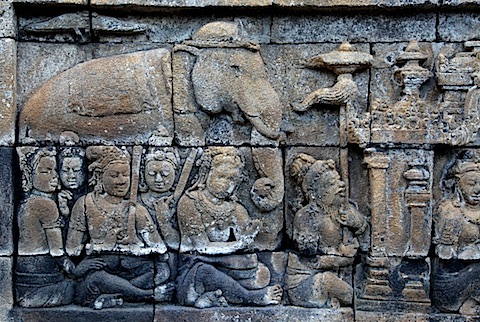




As if the carvings weren’t enough, when you get up higher up the levels become a series of stupas.


Each contains one Buddha as this denuded stupa shows:

Borobudur is easily in the top 10 most amazing places I’ve ever been. Try to arrive at 3:30 so that you can be there for sunset. It took is two hours to walk each level clockwise once (you’re supposed to do it three time oh of respect, but we just ran out of time).
7.
To get to Borobudur and Prambanan I recommend getting a driver. It’s only about $45 for a driver for the full day and the odds of you actually finding your way are about zero. Also, you ten don’t have to negotiate traffic like this:
Your driver will also demonstrate a ritual that is presumably used to reduce corruption. All parking lots charge a flat rate and require you to buy a ticket on the way in. But you won’t get out until you give the ticket back to a different guy on the way out. Maybe it’s a way to reduce corruption; maybe it just means more jobs for the boys.
As you drive around, you may get a sense of how Indonesians love stuffing anything into a truck. At various times we saw the following in the beds of pickup trucks:
- A giant bull
- Horses
- Hundred of chickens
- Hundreds of pounds of sugar cane stacked high and wide enough that there was no way the driver could have seen anything
Indonesians have a keen sense of trucks as tools (vs. the North American badge of membership to the clan redneck).
You might also see some begging at streetlights. No one just asks for money at the lights: the Javan version of squeegee kids clean your car with a feather duster; some people ‘serenade’ you with a tiny ukelele. And the ladyboys just dress up in their finest to surprise you.
8.
Jogja is also the first place in Indonesia where I’ve seen youth culture. The whole city is a (government-supported) canvas for street art. The emphasis is on figures and in contrast to North America, you do not see people scrawling their own tags over everything.




If American youth culture was once about cars, the malt shop and the drive-in, the Indonesian equivalent is the scooter and the Internet cafe. Everywhere you go you see scooters lined up outside them.


There are more scooters in Indonesia than people in Canada (and I don’t have any proof of that, but I’m sure it’s true). There are scooter garages where you can pimp your ride by giving it a new paint job or fancier decals. And choosing a fancy helmet is a sign of your personality.
The other place you can show your personality is at one of the youth-oriented clothing shops. Many are found on cuz road. Ironically, all look similar: one or two high contrast colours, bold signage and a plethora of stickers on the door.

In fact, this mimics a challenge Indonesia has: perfect competition. Every time someone has some success selling something, it seems like five other identical shops open up right next door. Witness these shoe shops selling exactly the same set of shoes:

Good for the consumer, but tough to really raise your overall standard of living.
9.
One thing that Wendy and I did was go to the mall (actually two of them).
Why did we go to a mall after flying halfway around the world?
Well, first, it’s Ramadan here and one of the few ways to get a solid meal during the day is to go to the mall (we weren’t alone; I quite enjoyed watching a woman in a hijab casually sip her coffee in public at the mall).
Secondly, when you watch how people shop I feel like you get a sense of who they are, where they’re at and where they want to go.
Here are some observations from our faux-shopping:
a)
The locals here have huge sweet tooths. The ‘jellied goods’ section is larger than the meats section of the supermarket:

b)
Pricing rules seem to be different here. Consider that the single serve Timtams below are cheaper per unit than a pack of eight:

c)
Wandering through the mall gives you a sense of how lax Indonesian respect for copyright law is.
We saw a ‘Polo’ store where not one good was over $20 and there was a sale on ‘strippers’ (I’m confident they meant stripes).
RIM’s Blackberry is a popular target for the Shanzai producers. Here’s their official logo:

Now witness these knock-offs:


By the way, the fact that China and Taiwan can create functional knock-off cellphones should give everyone pause as to their coming economic might. Businesses are going to have to be very careful about what they offshore vs. what they keep in-house and secret.
d)
The Indonesian woman has her own unique concerns. Consider the whitening deodorant and shampoo bottle that features no hair (to be fair, 90+ percent of deodorant is not whitening and almost all the shampoo bottles show women with lustrous black-and only black-hair).


e)
All the banal Western brands are here, albeit with package sizes and tastes that cater to local flavours. Many packaged goods also come in single serve sizes (although you can only buy those at traditional hawker markets, not at the mall):


f)
Shopping at the mall shows how sophisticated some of the companies here are. If you use your special Citibank Visa to buy select stores’ private label brands you get 5% (!) cash back.


Similarly, I was amazed when I dropped off $1.50 in laundry and was given a computerized claim ticket:
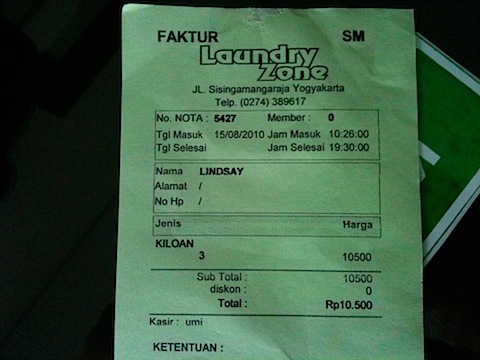
Contrast this with the scene elsewhere in Yogyakarta where brass weights are used to mass your fruit and ducks congregate outside the local cellphone retailer.


As Bobby Zimmerman said, the times they are a-changing.
10.
And now a treatise on drinking jungle cat poo.
Loyal readers will recall that in an earlier post I mentioned that I saw raw coffee luwak a.k.a. coffee made from civet poo – but that, alas, I was not prepared to try it.
Well, I am no longer a luwak coffee virgin.
When we were at the mall, the local Excelso coffee offered the coffee for only 65,000 Rupiah – about $7.50. This is the best price I’ve seen anywhere, so I thought I’d give it a try. When I ordered it, the waitress beamed with pleasure and gleefully told me that I was making an “economical” decision.
My joy rose when the coffee came; in order to prove that it really is jungle cat poo coffee, they provide you with the empty coffee bag attesting to its provenance. As I flipped through it, I felt like an otaku unboxing a phone.


As for the coffee, it was damn fine. It was one of the smoothest and lingering coffees I’ve ever had. I didn’t want it to end.
I’m also going to call it the second best cup I ever had. The best was the Kenyan at Clover’s Cafe in Brooklyn; the citrus infusions made the cup literally taste like orange juice by the time I got to the bottom.
11.
In closing, a few random observations.
a)
I’m sitting in a coffee shop writing this as a smooth jazzy bass line syncopates with the afternoon call to prayer. It’s an alluring sound that personifies the forces pulling at this society.
b)
There’s a cliche that white people find it difficult to tell Asian people apart. When I was a consultant, the new hires ha to make a comedic video and one year it featured two Asian consultants who worked 50% of the time by pretending they were each other. After the video was shown, one of the (white) senior partners walked up to a third Asian consultant and congratulated him on such a fine performance.
I’ve realized that the same applies to Asians with white people. At a restaurant in Prambanan, the waiter brought us the food of a different white couple. Twice. In a restaurant with only three couples in it.
The same thing happened at lunch again today except that there were only two couples in the restaurant.
c)
At the gas stations here, gas is only 50 cents a liter. Plus there are segregated prayer rooms for Muslims.
d)
Nobody walks here. There are sidewalks but they seem reserved for scooter parking or repair.
It might be due to the heat-which reduces Westerners to useless puddles of goo. It might also be a status thing (I’ve got a scooter!) as there’s still almost no one on the street at night.
e)
In addition to not walking, almost nobody wears shoes. At any given moment, 99% of the population is wearing sandals. The only people I saw wearing shoes worked at the mall.
f)
The quintessential local dish is gudeg (jackfruit) curry. I dragged Wendy to Lesehan Borobudur on Marlioboro road so that I could try some. It’s a great experience as you take your shoes off and eat on mats right next to the street.



Unfortunately there was no cutlery. Watching me try to eat my curry reduced locals to peels of laughter. Wendy’s blog has the definitive treatise. All I can say is imagine watching a child eat with a fork for the first time. It wasn’t pretty, bit it was hilarious. And delicious.
The other great dish to try here is Opor Ayam – a chicken curry in coconut sauce.
g)
The quintessential drink is a bandrek tea. A cousin is the kraton. Both are jasmine teas spiced with cloves, ginger, cardamon, cinnamon and nutmeg, served with a lemongrass stick as a stirrer.
h)
Yogyakarta has almost every type of transport known to man. Alongside such mundane forms as bus, taxi, train or the ubiquitous scooter are hundreds of trishaws (called becaks) and horse-drawn carriages (called andong). True fan of equine transportation may even find he odd jitney.


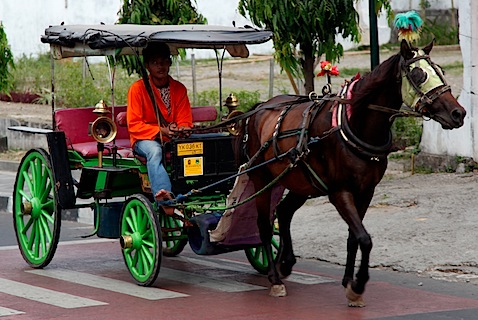
Alas, I found myself unable to take a becak as it brought back too many memories of my old job as a rickshaw runner.
i)
I’ve mentioned how people wanted to say hi when we walked down the river. In fact, as we’ve walked around town, lots of people have wanted to chat or have their photo taken.
I’ve come to the conclusion that having their photo taken makes people feel that they truly exist as someone outside their group of friends has noticed their existence.
These construction workers were adamant that we take their photo even though we have absolutely no idea who they are and will almost certainly never see them again:
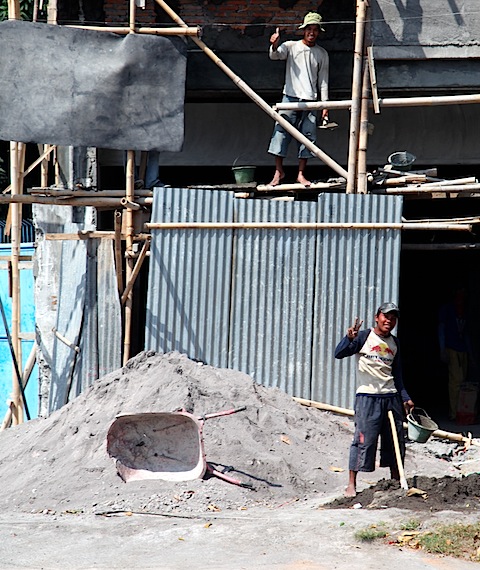
Similarly, one day as we were walking down the street a guy asked us if we would pose for photos with him and his family. We did and I shudder to think of what story he made up behind the photos. But everyone’s happy now.
j)
Bali and Yogyakarta have given me one of life’s little pleasures: the discovery of a new fruit. Until I came to Indonesia I had never tried the aptly-but-unfortunately named snakefruit:
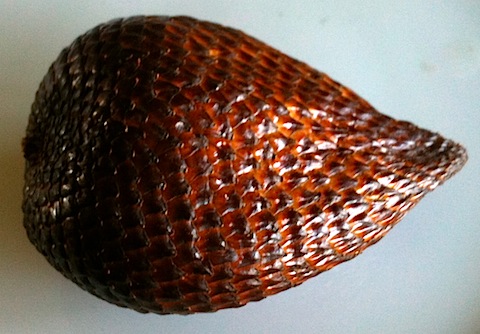
You peel away the interior to reveal two dry, smooth halves, each of which contains a nut. When you bite into each half they are very dry but also sweet. If you ever come across one, give it a try.
k)
And finally, a word of warning on traveling here if you are Dutch or French (like 90+% of the tourists). You may go native. Common symptoms are hirsutism and a propensity to batik or beaded shirts. Here is a subject:
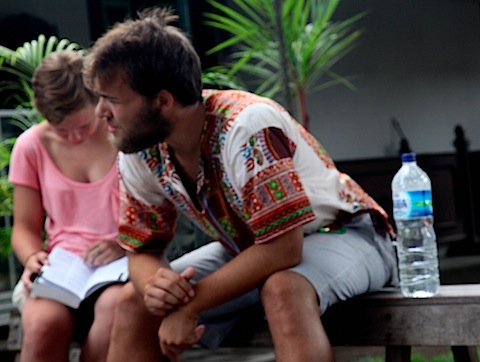
Make sure that you travel with someone who is immune to this and carries the appropriate book of runes or spells to help you break out of Indonesia’s trance.